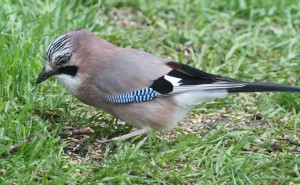 Judging by the E-mails from readers in the last three years, it looks as though one of the rarest of the crow family, the jay, is slowly increasing in the Highlands. The latest breeding pair have been reported from near Drumnadrochit where they successfully raised three or four young. By co-incidence I had one in the garden last week although it was only a brief visit to take some mixed grain so I hope it will be back again. When you think of the other members of the crow family, such as the rook, carrion crow or raven, they are no match for the brightly coloured jay. To start with the general body of the jay is an unusual colour for birds as it is a pinkish fawn and this contrasts with the wing feathers. These are black and white but are offset and in contrast to the famous small patch of bright blue and white feathers next to the white patch. The small patch of white feathers form a wing bar when the bird is in flight and contrasts sharply with the large white rump feathers that are very conspicuous but only when the bird is flying. The head has a small pale streaked crest that can be raised in display when the bird is excited. There is also a small but very conspicuous black moustache.
Judging by the E-mails from readers in the last three years, it looks as though one of the rarest of the crow family, the jay, is slowly increasing in the Highlands. The latest breeding pair have been reported from near Drumnadrochit where they successfully raised three or four young. By co-incidence I had one in the garden last week although it was only a brief visit to take some mixed grain so I hope it will be back again. When you think of the other members of the crow family, such as the rook, carrion crow or raven, they are no match for the brightly coloured jay. To start with the general body of the jay is an unusual colour for birds as it is a pinkish fawn and this contrasts with the wing feathers. These are black and white but are offset and in contrast to the famous small patch of bright blue and white feathers next to the white patch. The small patch of white feathers form a wing bar when the bird is in flight and contrasts sharply with the large white rump feathers that are very conspicuous but only when the bird is flying. The head has a small pale streaked crest that can be raised in display when the bird is excited. There is also a small but very conspicuous black moustache.
The jay has always been considered sedentary, rarely moving more than a few kilometres from where it was hatched. However, this has not stopped the modest increase in range in recent years when the Great Glen has proved invaluable in allowing it to spread up both west and east sides of Loch Ness. There seems to be no doubt that the Great Glen is a major migration route for a whole range of birds from seabirds to warblers and thrushes to waders. For the woodland birds it must be a major haven and surely the extensive long woodlands, both conifers and broadleaves, are so vast that they match any other continuous tracts of trees in the UK. There is one specialised food plant that seems to limit the spread of the jay and that is the acorn. This food source may be the inhibiting factor that has stopped virtually any other spread of the jay outside the Great Glen ranging from Inverness down to Fort William. They will feed on acorns all the year round by caching them in the ground and in holes and crevices in trees. Those on the ground that are missed can grow into oak trees so once again helping the spread. Unfortunately the annual crop of acorns is notoriously fickle and when the crop is poor other food sources have to be found. This can include insects, especially caterpillars, but they also, unfortunately, have a liking for the chicks of birds which brings them in conflict with other birds and man. Where the jays are common such as down south, they are often persecuted for their predation on eggs and chicks of game birds that have been reared for shooting.
Although it has not colonised all of the Highlands, as yet, it still has a number of Scots names such as Blue Jay, Jay Pyot, Kae an Oak Jay. There is only one Gaelic name I could find and that is Sgraicheag choille meaning Screecher of the woods which just about sums up its strident call notes. The jay’s Latin name, glandarius, means acorn and refers to the birds preference for this food source. One myth is that the jay lines its nest with magical stones, causing invisibility, and this accounts for the nests being very difficult to find!
Tags: highland birds
